
Hasegawa 1/72 Lockheed P-3C (Block IIIA) JMSDF
By Chris Banyai-Riepl
Overview
The Lockheed P-3 Orion was a military adaptation of the Electra airliner, designed to replace the P-2 Neptune in the role of land-based ASW. Entering service in the early 1960s, the P-3 found its way into the services of many nations around the world, including Argentina, Canada, Germany, Iran, Norway, Portugal, Taiwan, Thailand, and Japan. Over the years, the aircraft has undergone many upgrades, with the latest Japanese type featuring additional bumps on the fuselage.
The Kit
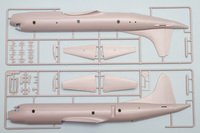 Hasegawa's 1/72 P-3C Orion kit has been around for quite a few years, having been originally released in the early 1980s. Since then it has been re-released many times, including recently by Revell Germany. It remains the only choice for a 1/72 P-3 Orion. The kit is molded in light gray plastic, and features raised details throughout. In addition to the original plastic parts, this kit also includes resin details to bring the model up to the Block IIIA JMSDF standards. This matches the decal sheet, which provides markings for two current JMSDF P-3 Block IIIA Orions.
Hasegawa's 1/72 P-3C Orion kit has been around for quite a few years, having been originally released in the early 1980s. Since then it has been re-released many times, including recently by Revell Germany. It remains the only choice for a 1/72 P-3 Orion. The kit is molded in light gray plastic, and features raised details throughout. In addition to the original plastic parts, this kit also includes resin details to bring the model up to the Block IIIA JMSDF standards. This matches the decal sheet, which provides markings for two current JMSDF P-3 Block IIIA Orions.
For those not familiar with the Hasegawa P-3 kit, it does have a fair amount of useful detail to it. The cockpit is the first step, and here you get three separate seats, separate control columns, and a separate instrument panel. These all fit onto the cockpit floor, which has the center console molded in place and gets a separate rear bulkhead. The instrument panel and center console get decal instruments for detailing. Given the small cockpit windows and closed-in view, the stock kit details are probably going to be sufficient.
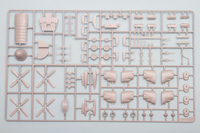 The cockpit fits well into the fuselage halves, and there is plenty of room for the required weight (of which the instructions suggest 30 grams will be needed). Before attaching the fuselage halves together, the instructions also direct you to drill out a small window on the left side. The sonobuoy section is a separate insert to provide crisper detailing. Once the main fuselage is together, you can add the separate nose (another location for weight) and tail stinger.
The cockpit fits well into the fuselage halves, and there is plenty of room for the required weight (of which the instructions suggest 30 grams will be needed). Before attaching the fuselage halves together, the instructions also direct you to drill out a small window on the left side. The sonobuoy section is a separate insert to provide crisper detailing. Once the main fuselage is together, you can add the separate nose (another location for weight) and tail stinger.
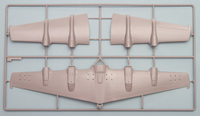 Moving on to the wings, these are split into separate right and left upper pieces and a one-piece lower wing part. While the instructions have you build the wings up first, then attach to the fuselage, I would recommend attaching the lower wing first, and then the upper halves, as that allows for test fitting to minimize seam work. The engine nacelles are all separate as well, and are made up from separate halves and a separate front. A prop shaft completes the nacelle assembly, and with the addition of those to the wings, plus the exhaust pipes, finishes the wing assembly.
Moving on to the wings, these are split into separate right and left upper pieces and a one-piece lower wing part. While the instructions have you build the wings up first, then attach to the fuselage, I would recommend attaching the lower wing first, and then the upper halves, as that allows for test fitting to minimize seam work. The engine nacelles are all separate as well, and are made up from separate halves and a separate front. A prop shaft completes the nacelle assembly, and with the addition of those to the wings, plus the exhaust pipes, finishes the wing assembly.
For the small details, the kit has all the various fuselage blade antennae as separate parts, which is nice as you won't be knocking these off sanding the fuselage seams. There are some armament bits, consisting of two torpedoes, and there are separate pylons for the lower wing. The landing gear is sturdy, with separate actuator struts and wheels. For the clear parts, the windscreen is separate, as are the handful of fuselage windows. A nice bonus is the addition of the crew ladder for the rear door. This is often seen down on parked aircraft, so having it in the kit is a big plus.
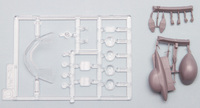 The resin bits included in the kit are very well done. Hasegawa has been doing some great stuff in resin, and this is no exception. The most prominent is the large antenna bulge for the top of the fuselage, followed closely by the replacement underwing pod. The smaller details are the small sensors on the nose and tail. As these are add-on details, the separate instruction sheet provides very detailed information for proper placement, as well as all the other details you will need to be aware of to build a Block IIIA P-3C.
The resin bits included in the kit are very well done. Hasegawa has been doing some great stuff in resin, and this is no exception. The most prominent is the large antenna bulge for the top of the fuselage, followed closely by the replacement underwing pod. The smaller details are the small sensors on the nose and tail. As these are add-on details, the separate instruction sheet provides very detailed information for proper placement, as well as all the other details you will need to be aware of to build a Block IIIA P-3C.
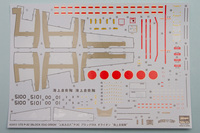 The decal sheet is large, but the actual markings are fairly bland. As the kit subject is a current JMSDF P-3C, there is little more than national insignia and serial numbers needed. What makes up the majority of the decal sheet, then, is all the extra stenciling found on the plane. This includes large decals for the wing walkways and tailplane walkways, as well as all the propeller and engine warning markings, rescue arrows, and other details. The two options are for a P-3C from Fleet Air Wing 2, 2nd Squadron, Hachinohe AB and a P-3C from Fleet Air Wing 4, 3rd Squadron, Atsugi AB. Both are finished in overall gray, with darker gray radomes.
The decal sheet is large, but the actual markings are fairly bland. As the kit subject is a current JMSDF P-3C, there is little more than national insignia and serial numbers needed. What makes up the majority of the decal sheet, then, is all the extra stenciling found on the plane. This includes large decals for the wing walkways and tailplane walkways, as well as all the propeller and engine warning markings, rescue arrows, and other details. The two options are for a P-3C from Fleet Air Wing 2, 2nd Squadron, Hachinohe AB and a P-3C from Fleet Air Wing 4, 3rd Squadron, Atsugi AB. Both are finished in overall gray, with darker gray radomes.
Conclusion
This is a nice re-release of the classic Hasegawa P-3 kit, and the inclusion of the resin bits open up some extra potential as the smaller piece are also found on other nations' P-3Cs. Perhaps we will see other re-releases down the road with some of the other different antenna fittings for a current USN fleet P-3C. My thanks to Hasegawa USA for the review sample.
